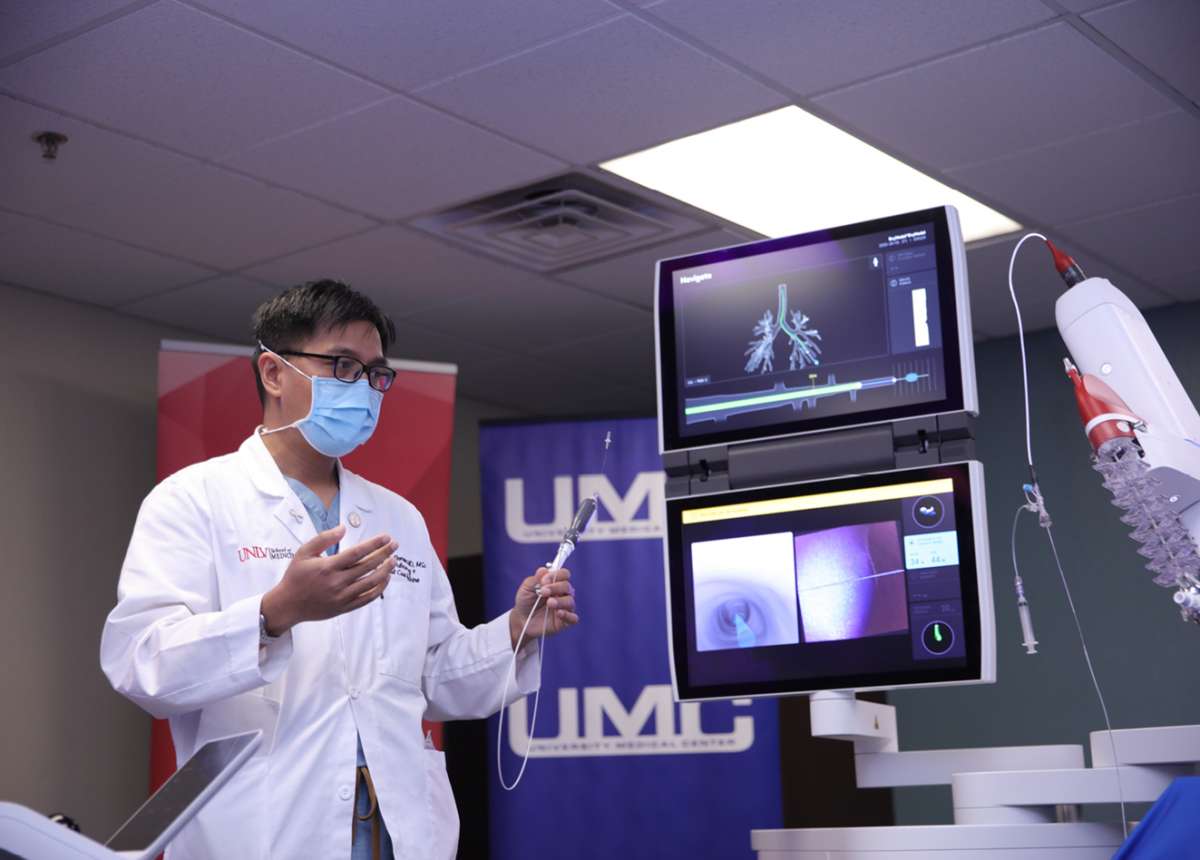Early Detection of Lung Cancer

Dr. Arthur Oliver Romero demonstrating the Ion platform on a lung model during an event at UMC in June 2021.
UMC, in partnership with UNLV Medicine, recently became the first and only hospital in the state to introduce the groundbreaking Ion system, a robotic-assisted platform for minimally invasive lung biopsy procedures. This technology now plays a vital role in the life-saving efforts of UMC’s Interventional Pulmonology Program, the only program of its kind in Nevada.
Providing new levels of precision, reach, and stability when compared to traditional bronchoscopy biopsy techniques, the Ion system helps address a challenging aspect of lung biopsies. The system allows physicians to collect tissue samples from smaller targets deep within the lung to help detect cancer. While it can be difficult to diagnose early-stage lung cancer, the Ion system helps physicians obtain tissue samples to facilitate an early diagnosis.
This advanced technology has already produced life-changing results for UMC patients like Kurt Blakeman, a 67-year-old North Las Vegas man who underwent the state’s first robotic navigation biopsy using the Ion system in June. The procedure was performed by Dr. Arthur Oliver Romero, UMC Interventional Pulmonologist and Assistant Professor of Pulmonary and Critical Care Medicine with the Kirk Kerkorian School of Medicine at UNLV. Dr. Romero is the first fellowship-trained, and only board-certified interventional pulmonologist, in Nevada.
“After collecting a tissue sample with the Ion robotic system, we detected Mr. Blakeman’s lung cancer at an incredibly early stage,” Dr. Romero says. “When it comes to promoting the best possible outcomes for lung cancer patients, nothing beats an early diagnosis. When we detect cancer early, it provides patients like Mr. Blakeman with the best possible chance of survival and sustained quality of life.”
Following the Ion procedure, Dr. Romero and his colleagues at UMC worked to move Blakeman through the treatment process as rapidly as possible. Within weeks, Cardiothoracic Surgeon Dr. Walter Ehrman performed surgery at UMC to successfully remove the small tumor from Blakeman’s lung.
“I’m just happy that they caught it in time,” Blakeman says, expressing gratitude toward Dr. Romero and the other UMC team members who cared for him. Blakeman, a lifelong resident of Southern Nevada, has fully recovered from the surgery, and looks forward to resuming the activities he enjoys as a retiree, including fishing trips with his friends.
By diagnosing Blakeman’s lung cancer at such an early stage, Dr. Romero said the clinical team was able to offer curative surgery and avoid chemotherapy and radiation, which can have significant side effects. If the cancer went undetected and continued to spread, Blakeman may have also needed a more extensive surgical procedure to remove a larger section of the lung, which can severely impact lung function and overall quality of life.
Blakeman says the Ion robotic navigation biopsy procedure, which initially detected his lung cancer, only took a matter of hours, allowing him to return home the same day. He returned to UMC several weeks later for the surgery to remove the tumor.
During biopsy procedures with the Ion robotic platform, the physician uses a controller to navigate to the target along a planned path. Dr. Romero explains that the system maps out the patient’s lungs, providing valuable information to guide physicians. The inserted catheter can articulate 180 degrees in any direction, allowing it to pass through small, difficult-to-navigate airways and around tight bends so it can reach all segments of the lung. During navigation, Ion’s peripheral vision probe also provides direct vision through a nearby monitor.
“As a result of this technology, we’re able to safely reach areas of the lung that were previously inaccessible,” Dr. Romero says. “The system represents a valuable step forward in our ongoing fight against lung cancer in Nevada.”
The minimally invasive Ion technology also helps reduce the risks associated with traditional biopsy techniques, which involve puncturing the outer surface of the lung with a long needle. Dr. Romero notes that certain patients, such as those with severe emphysema, have a high risk of sustaining collapsed lungs from needle lung biopsies and will benefit from this new technology.
Looking toward the future, Dr. Romero says he expects the Ion technology to eventually support the direct treatment of lung cancer.
“In three to five years, we will likely have the ability to provide minimally invasive lung cancer treatment using the Ion robotic platform,” he says, explaining that a specialized catheter is currently in development to allow physicians to destroy lung tumors using heat therapy. Once available, this minimally invasive form of treatment may eliminate the need for some surgical procedures to remove lung tumors.
With patients already benefitting from the lung cancer detection capabilities of this new technology, UMC CEO Mason Van Houweling points out that the introduction of the Ion robotic system serves as a reflection of UMC’s unwavering commitment to innovation.
“UMC continues to serve as our state’s most sophisticated hospital, providing community members with access to the latest breakthroughs in clinical technology,” Van Houweling says. “The Ion robotic system serves as a valuable tool to help our world-class clinicians diagnose lung cancer and move patients rapidly to treatment.”
Learn More
For more information about the Ion platform and UMC’s Lung Cancer Screening Program, community members can call UMC’s Oncology team at 702-667-7687.
